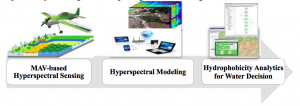Project Introduction
The long-term goal of this SEED project is to establish a research, education and extension center of excellence in soil-water sensing and computing, which is dedicated to enhancing rational decision-making for agricultural water use at a global setting. This integrated project will be carried out in two years by an interdisciplinary group of researchers, educators, and graduate students at three universities between the US and Israel. With carefully designed research and educational efforts, the objective of this hypothesis-driven project is to develop a soilhydrophobicity analytics system with rapid and cost-effective hyperspectral imaging and computing capabilities. To achieve this, the emerging micro-unmanned aerial vehicles (microUAV or MAV) will be used as the basic platform.
Figure presents a conceptual solution framework corresponding to the proposed objective. Through scientific discovery, system prototyping, algorithm development, and synergistic educational activities, the interdisciplinary and collaborative Project Team aims to realize three supporting objectives: 1) To demonstrate that soil hydrophobicity can be sensed and identified through hyperspectral imaging and hyperspectral data mining; 2) To develop a novel MAV-based soil-hydrophobicity analytics system with both laboratory and field verification; 3) To build an internationally collaborative research and education infrastructure focusing on soil-hydrophobicity sensing and computing for soil and agriculture sciences.
Upon completing this project, the Project Team will establish tangible competitiveness in: (1) A first-of-its-kind soil-hydrophobicity analytics platform that can be rapidly deployed; (2) New knowledge and publishing records in novel hyperspectral data mining algorithms; (3) A frontier research/education infrastructure with a long-term sustainable goal of innovating tools for rational agricultural water management. Based on such competitiveness, the Project Team will continue seeking domestic and international funding opportunities for applied development and validation of soil-hydrophobicity analytics platforms for water-centric agricultural and environmental monitoring applications. Particularly, while forming extension partnerships with practice experts at both nations, the Project Team will apply for integrated CAP grants through the future NIFA solicitation
